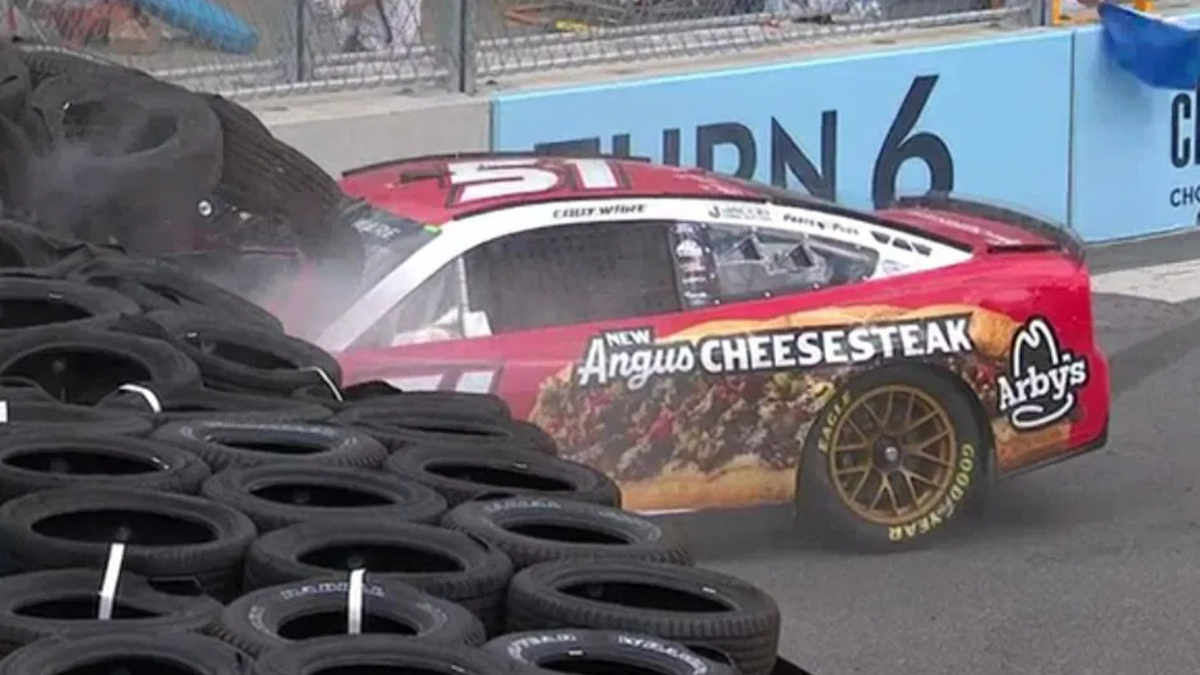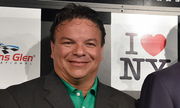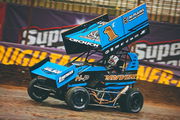

What does it take for a driver to commit to crashing into a wall, on purpose? Well, Ross Chastain did ride the wall at Martinsville to punch a ticket for the championship race in 2022. Even Christopher Bell tried to use this trick to his advantage in a controversial playoff race last year. However, last weekend in Chicago, Cody Ware had to resort to similar means, not because he was trying to gain an advantage, but rather to avoid a major pileup or wreck.
Watch What’s Trending Now!
Cody Ware encountered a disastrous rotor failure that sent his No. 51 Ford crashing into the tire barriers. It was a massive crash, so much so that the HANS device and the steering wheel snapped, and the driver was under the tire barrier for good thirty seconds, and yet, NASCAR didn’t drop the yellow flag. Chris Buescher, who was right behind Ware, applauded him for the presence of mind in making that split-second decision.
ADVERTISEMENT
Chris Buescher was glad that Cody Ware was fine after the bone-chilling crash.
It was Lap 31 of the Chicago Street Race, a tight, tricky race with no room for error and a concrete frame. When the catastrophe occurred, Cody Ware had just entered Turn 6, one of the quickest braking zones on the 2.2-mile temporary circuit. His brake rotor abruptly and unexpectedly failed. Ware had to rely on instinct and training since he lacked braking power. Buescher, running just behind Ware at the time, had a clear view of the crash and didn’t hesitate when reflecting on what he witnessed. “I saw the park scene as soon as it happened,” Buescher told Frontstretch. “It was a massive hit, so I’m really glad that Cody is okay. I commend him for turning it right. That is the hardest thing,” he explained. “Your instinct is always to turn away and say, ‘I’m going to save this.”
As a former road course champion and renowned for his technical consistency, Buescher understood the importance of Ware’s choice at that particular moment. Ware turned aggressively into the wall, taking the hit head-on, rather than attempting to rescue the car and risking a catastrophic trajectory down the straight or into another car. It was a standard “scrub” tactic that used the car’s body against the barrier to reduce speed. The vehicle suffered severe damage and destroyed the right-front suspension in its powerful ricochet. Based on data systems maintained by NASCAR, the hit registered close to 50 Gs.
Turning into the wall instead of away from it was a counterintuitive maneuver that lessened the chance of running into traffic or colliding with a perpendicular wall at full speed. Ware’s day was ruined by the crash, but Buescher pointed out that without that sacrifice, things might have turned out far worse. Technical assessments following the race indicate that several teams recorded high rotor temperatures, some of which exceeded 1,400°F under braking. Front brake assemblies are subjected to tremendous strain on street circuits when hard braking occurs quickly after one another.
ADVERTISEMENT
“Typically, you don’t get a warning. It’s just that initial stab of the pedal, and it blows apart, and you’re along for the ride. It sucked. But on a street course like that, that’s all you can do. He did everything right,” Buescher said of rotor failures. Ware’s No. 51 had been putting in consistent laps despite being among the backmarkers at the time. After the race, crew chief Carl Long verified that telemetry revealed no indications of rotor deterioration before failure. It wasn’t until the system failed spectacularly that the problem, likely a structural crack, was discovered.
“That impact was massive” –@Chris_Buescher glad that Cody Ware is OK after the hard head-on crash in the tires at Chicago.
He also talks about the number of road courses on the schedule and his strengths at Sonoma. #NASCAR pic.twitter.com/S9RcP9YL2n
— Frontstretch (@Frontstretch) July 12, 2025
ADVERTISEMENT
The fact that Ware survived the collision unscathed is evidence of NASCAR’s most recent Next Gen safety innovations, which include strengthened front clips and the revised energy-absorbing foam that was required in 2024. But his car was a complete wreck. To tighten the field and rearrange tactics, the yellow flag was raised for six laps during cleaning. Although Buescher would end in 14th place, his analysis of Ware’s split-second response was more significant than the final ranking. Cody Ware’s crash served as a lesson in split-second sacrifice in a race when the difference between triumph and disaster is measured in milliseconds.
Top Stories
Greg Biffle’s $4M Worth Prized Possession Still Without a Buyer Leaves NASCAR Fans Heartbroken

NASCAR World Mourns as Former Watkins Glen President Michael Printup Passes Away at 60

Fox Broadcaster Pens Heartfelt Message as Veteran Announcer Quits NASCAR

Denny Hamlin Offers First Words Since Losing Beloved Father in Anniversary Fire

“This Is Not Racing”: Growing Outrage Erupts Over How Kids Are Being Taught to Win at Any Cost in Modern Motorsports

NASCAR’s officiating comes under fire again
Not only did Cody Ware’s horrific crash during the last laps of the 2025 Chicago Street Race crack the tire barrier, but it also revealed serious flaws in NASCAR’s cautionary procedure. Heading into Turn 6, Ware’s No. 51 car experienced a front brake rotor failure as the pack raced into the white flag. Chris Buescher, a fellow driver, applauded his instincts when he purposefully turned into the wall to scrub speed and avoid a more hazardous trajectory while traveling at over 90 mph without any stopping power.
ADVERTISEMENT
NASCAR’s reaction, however, was slow. It took more than 30 seconds for race control to issue the caution, even though the hit was severe and the corner worker had called “6” over the radio. Shane van Gisbergen crossed the start/finish line and took the white flag during that time, ensuring a caution-finished race and removing Tyler Reddick’s possibility of a green-flag duel with him as Reddick closed closer on fresher tires.
Later, NASCAR acknowledged that they weren’t aware of the severity of the impact because of a clear view of the crash. The delay sparked concerns about NASCAR’s real-time crash monitoring capabilities. Further weaknesses in NASCAR’s communication line were shown when Ware barely said, “Need help,” on his radio, but the request was not immediately followed through on. NASCAR track marshals are not authorized to issue full-course cautions, unlike F1 or IMSA; only race control in the tower has this power. This is not the first time a race finish has been influenced by a delayed caution. A 2024 incident involving Leland Honeyman at Charlotte drew similar criticism.
The sport is under increasing pressure to update its cautionary practices as NASCAR adds additional street and road courses, where sightlines are not clear like ovals.
ADVERTISEMENT
ADVERTISEMENT
ADVERTISEMENT
ADVERTISEMENT

